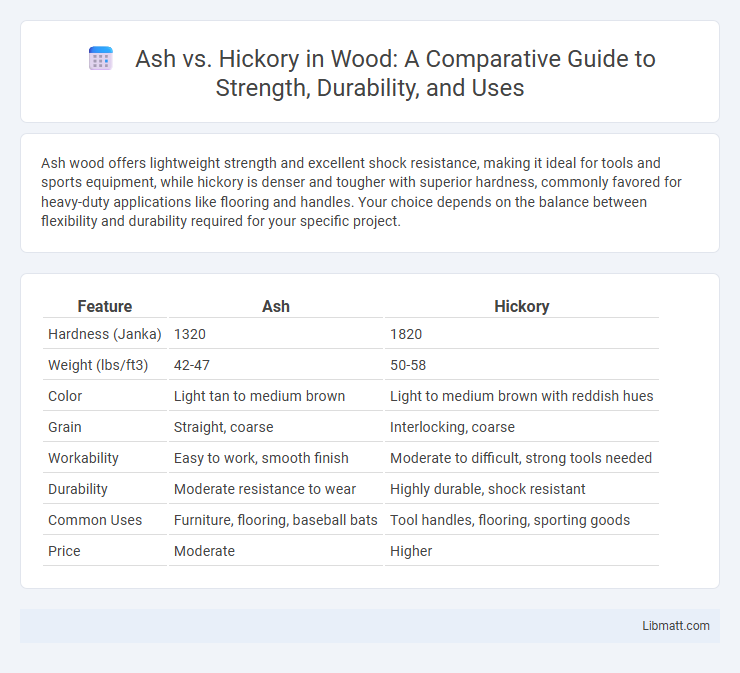Ash wood offers lightweight strength and excellent shock resistance, making it ideal for tools and sports equipment, while hickory is denser and tougher with superior hardness, commonly favored for heavy-duty applications like flooring and handles. Your choice depends on the balance between flexibility and durability required for your specific project.
Table of Comparison
| Feature | Ash | Hickory |
|---|---|---|
| Hardness (Janka) | 1320 | 1820 |
| Weight (lbs/ft3) | 42-47 | 50-58 |
| Color | Light tan to medium brown | Light to medium brown with reddish hues |
| Grain | Straight, coarse | Interlocking, coarse |
| Workability | Easy to work, smooth finish | Moderate to difficult, strong tools needed |
| Durability | Moderate resistance to wear | Highly durable, shock resistant |
| Common Uses | Furniture, flooring, baseball bats | Tool handles, flooring, sporting goods |
| Price | Moderate | Higher |
Ash vs Hickory: An Overview
Ash and hickory are both hardwood species commonly used in furniture and tool handles, but they differ significantly in density and shock resistance. Ash wood is lighter and more flexible, making it ideal for baseball bats and sports equipment, while hickory is denser and harder, preferred for heavy-duty applications like flooring and axe handles. The grain structure of ash provides better elasticity, whereas hickory's toughness offers superior durability under stress.
Wood Characteristics: Ash and Hickory
Ash wood features a light color, typically creamy white to light brown, with a straight grain and a smooth texture that makes it ideal for furniture and sports equipment. Hickory is denser and harder, exhibiting a reddish-brown hue with a more varied grain pattern, prized for its durability in tool handles and flooring. Both woods offer excellent shock resistance, but hickory's superior toughness makes it more suitable for heavy-duty applications.
Strength and Durability Comparison
Ash wood offers impressive strength and flexibility, making it ideal for applications requiring shock resistance and durability, such as tool handles and sports equipment. Hickory exceeds in hardness and impact resistance, providing exceptional toughness suitable for heavy-duty use and high-stress environments. Your choice between ash and hickory should consider the balance between flexibility and hardness needed for your specific project or product.
Grain Patterns and Aesthetics
Ash features straight, pronounced grain patterns with a light, creamy color that enhances its traditional and rustic aesthetic appeal. Hickory exhibits more variation with bold, contrasting grains and a darker, reddish-brown hue, offering a striking and dynamic look for furniture or flooring. Your choice between ash and hickory will depend on whether you prefer a consistent, understated grain or a visually rich, textured finish.
Workability: Ease of Use
Ash wood is renowned for its excellent workability, offering ease of cutting, shaping, and finishing due to its straight grain and moderate hardness. Hickory, while tougher and denser, demands more effort and sharper tools during machining but provides superior strength for heavy-duty applications. Both woods exhibit good nail and screw holding power, though ash is preferred for projects requiring smoother handling and faster production.
Cost and Availability
Ash wood is generally more affordable and widely available than hickory, making it a budget-friendly choice for various woodworking projects. Hickory tends to be more expensive due to its exceptional hardness and durability, which also makes it slightly harder to source in large quantities. Your decision between ash and hickory should consider both budget constraints and local lumber supply options to ensure the best value.
Common Uses: Ash vs Hickory
Ash is commonly used for sports equipment like baseball bats and tool handles due to its shock resistance and flexibility, while hickory excels in applications requiring superior strength and durability, such as furniture, flooring, and axe handles. Both woods offer excellent hardness, but hickory's dense grain makes it ideal for heavy-duty tasks, whereas ash provides a lighter weight alternative without sacrificing toughness. Your choice between ash and hickory depends on whether you prioritize lightness with resilience or maximum strength for demanding use.
Maintenance and Longevity
Ash wood offers moderate maintenance with regular sealing recommended to prevent moisture damage, ensuring durability for around 15-20 years in typical conditions. Hickory requires more frequent upkeep due to its dense grain, but it boasts exceptional hardness that translates to superior resistance to dents and scratches, often lasting over 25 years with proper care. Choosing between ash and hickory depends on your willingness to maintain the wood and desired longevity for your project.
Environmental Impact
Ash wood offers a sustainable option due to its rapid growth and widespread availability, resulting in a lower environmental footprint compared to hickory, which grows more slowly and requires longer harvest cycles. Your choice of ash supports reforestation efforts and reduces habitat disruption, whereas hickory harvesting can contribute to ecological strain because of its increased demand and slower replenishment rates. Both woods are biodegradable, but ash's faster regeneration rate aligns better with environmental conservation goals.
Choosing the Right Wood: Ash or Hickory
Choosing between ash and hickory wood depends on your project needs and desired durability. Ash wood is lightweight and flexible, making it ideal for tool handles and sports equipment, while hickory offers superior strength and shock resistance, perfect for heavy-duty applications like flooring and furniture. Your choice should balance the wood's hardness, grain pattern, and resilience to ensure optimal performance and longevity.
Ash vs hickory Infographic

 libmatt.com
libmatt.com